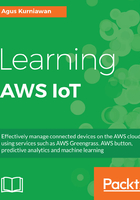
Introducing AWS IoT
In recent years, there have been a lot of IoT boards built by either manufacturers or indie makers. Each IoT offers unique features to build IoT applications to address users problems. Sensor and actuator devices are attached to these IoT boards to generate data. There is a lot of sensor data from IoT devices that we can analyze.
Suppose we have various IoT boards that are deployed on some locations. Since these IoT devices generate sensor data, we need a backend server with high availability to serve incoming data. In particular cases, we also need to analyze the data to obtain insights. To perform this scenario, we need more computing engines, such as storage and machine learning engines.
The general design of AWS IoT architecture is illustrated in the following figure. There are several components inside AWS IoT, including its endpoints. IoT devices can access AWS IoT through the AWS message broker with their own SDK. AWS IoT also provides SDK for various IoT device platforms. Using AWS IoT SDK, IoT devices can access AWS IoT directly. We will review some AWS IoT SDK, including its protocol and API, throughout this book. The AWS IoT components are shown in the following image:

From the preceding figure, we can see the following AWS IoT components:
- Message broker: This is basically an AWS IoT endpoint where IoT devices can access the AWS server through the Message Queuing Telemetry Transport (MQTT) protocol. Message broker also supports primitive protocols, such as the HTTP protocol. Your IoT device can send data with AWS IoT through HTTP REST.
- Thing Registry: This manages all the IoT device administration. You can register and configure your IoT devices, including configuring certificates and IoT device IDs.
- Thing Shadows: This refers to a device shadow that has functionalities to keep the current state information for a specific thing in a JSON document.
- Rules Engine: This provides message processing and integration with other AWS services. If you have deployed AWS services, you can apply a rule engine on those services.
Some AWS IoT components will be explored in this book.